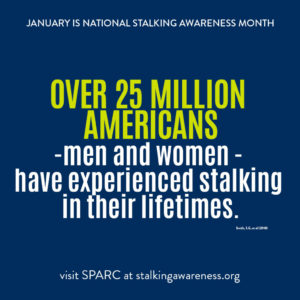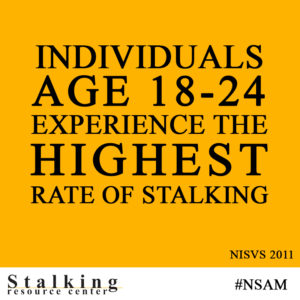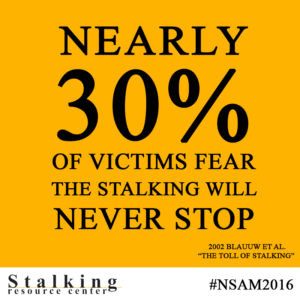Stalking is a serious crime that can take a long-term emotional, physical, and financial toll on survivors. Despite the high-profile or celebrity cases involving stranger stalkers, stalking is most often perpetrated by someone the survivor knows and is defined as a patter of behavior directed towards a specific individual causing them to feel fear.
Stalking affects millions of women and men in the United States.
Stalking occurs when someone repeatedly harasses or threatens someone else, causing fear or safety concerns. Most often, stalking occurs by someone the victim knows or with whom they had an intimate relationship.
Help prevent stalking by knowing the warning signs and how to get help.
Stalking tactics can include:
- Unwanted phone calls
- Unwanted emails, instant messages, text messages, voice messages, or social media messages
- Approaching a victim or showing up unwanted, such as at the victim’s home, workplace, or school
- Leaving strange or potentially threatening items for the victim to find
- Watching, following, or tracking a victim
- Sneaking into the victim’s home or car and doing things to scare the victim or let them know the perpetrator had been there
According to the National Intimate Partner and Sexual Violence Survey (NISVS):
- Stalking is common. About 1 in 6 women and 1 in 17 men have experienced stalking in their lifetimes.
- Stalking starts early. Nearly 54% of female victims and 41% of male victims experienced stalking before the age of 25.
- Stalking impacts the physical and mental health of victims. Research shows stalking can lead to depression and post-traumatic stress disorder. About 68% of female and 70% of male victims experienced threats of physical harm during their lifetime.
Child Stalking
Many times, we hear young adults say that they “Facebook stalked” someone, which simply means they looked through someone’s profile and photos for certain information. This is meant in a joking manner, but stalking is a scary and real thing. It happens more often to young adults, and is becoming easier with modern day technology.
- Over 85 percent of stalking victims are stalked by someone they know, (many times it is a current or former intimate partner).
- In the U.S., 7.5 million people are stalked each year.
- Young adults ages 18-24 experience the highest rates of stalking.
- Women are stalked 2x higher than men
What Can You Do?
If you feel like you or your child are being stalked:
- Document it. Whether it’s happened twice or 20 times, jot down the incidents and note the date, time, location and any other details that you remember.
- Contact your local police department or stalking unit to report it. Having documented proof of the stalking could assist you in receiving a protection order. A legal advocate will be available to help you through the court process.
- Notify a friend, family member, employer or any other organization with whom you are involved.
- Contact a local agency, such as The Center for Family Safety and Healing, to get help in creating a personalized safety plan.
- If you feel you’re in immediate danger, call 911.
- Get a protection order. Contact your local prosecutor’s office for information on the process for filing.
Everyone can work together to know, name, and stop stalking by:
- Helping others define and recognize stalking behaviors
- Mobilizing men and boys as allies in prevention efforts
- Creating and supporting safe environments within relationships, schools, and communities through programs and policies that promote healthy relationships



